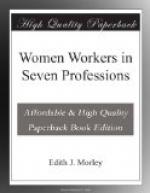We must now return to give a few particulars which have been passed over. Any information on this subject is, however, liable to be very soon out of date. A secondary school that elects to teach cooking and laundry work will want a specially fitted room, which will cost about as much as a simple science laboratory, and will be arranged in as close connection with the science laboratory as is convenient. This means serious expense, and the headmistress is naturally anxious to have considerable use made of the room. Thus she will be led to introduce the subject into a large proportion of the classes, instead of limiting it to one or two middle-school forms, or to a selected part of the upper-school. She may, however, try to solve the economic problem by making it a post-school course for which special fees are charged. Certain schools, notably Clapham and Croydon High Schools and Cheltenham Ladies’ College are able to make a very important feature of this type of course. To make it a success, the prestige of the school, its influence over girls and their parents, must be great and commanding. Otherwise, unless the girls are aiming definitely at some professional work after the course, there is a tendency to laxness in attendance, or to the relinquishment of the work in the middle, which tendency is engendered by the nature of the subject. The mother’s excuse for getting her grown-up girl’s company and help will naturally be, “Gladys can boil the potatoes at home instead of at school.” A valid answer will be that Gladys is being taught to free her mind from the eternal English boiled potato by learning many other ways of treating it, and at the same time learning its proper place in a diet.
Failing the post-school course, the admittance of domestic subjects to a notable place in the general school curriculum leads to great stress being laid on the teaching of the elements of Physical Science. The eminently “feminine” subject, Botany, gives place to Physics and Chemistry in the middle-school, followed by Physiology and Hygiene in the upper-school. The subjects are to be illustrated whenever convenient, by reference to home life. A student choosing her science subjects at College should bear these in mind as likely to be at present of the best market value. Though it is very true that a practical woman who is a good teacher will nowadays connect any science subject with home life, still a parallel course of domestic arts will draw chiefly on the lessons given in these four.
Another fact worthy of notice is that a married woman who is anxious to continue her former profession of science teaching will not as a rule have to suffer the usual unfavourable handicap. That a married woman should teach the domestic subjects is quite a reasonable proposition to many who would exclude her from most professions: if she be also a mother it may even count as an asset instead of a disadvantage.




